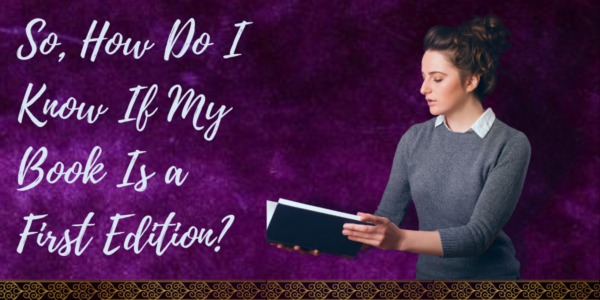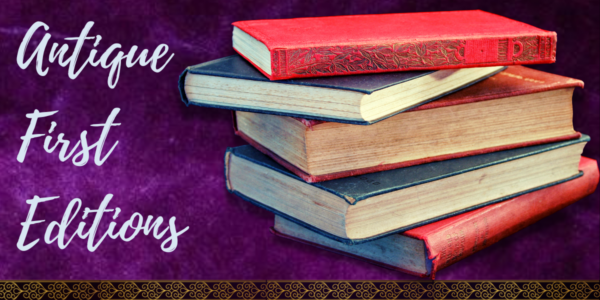Have you ever gazed across your book collection, wondering if any of them might be valuable? Or perhaps you’ve inherited an antique book and daydreamed that it’s worth a small fortune?
Unfortunately, most second-hand books don’t sell for much, but that’s not always the case. If you have a first edition in your collection, you may be on to a winner.
Everything You Need to Know About First Edition Books
While not all first-edition books are valuable, if you have one on your shelves, it’s worth hanging onto. Just because it’s not a collector’s item yet, doesn’t mean it won’t be in 10 or 20 years’ time!
But if you’ve never delved into the mind-boggling world of book valuation, you may be wondering what exactly a first edition book is and how to tell if you have one in your own collection.
So, in this post, I’ll explain everything you need to know about the first edition books, including what they are, why they’re often valuable, and how to figure out if you’ve got one.
What Is a First Edition?

The term ‘first edition’ is pretty self-explanatory; it’s the first printed and distributed version of a book.
Most popular books will have multiple print cycles, and often, there are minor changes to both the cover and the contents with each reprint.
But a first edition is a book in its original form, exactly how it was released for the very first time.
Why Are First Editions More Valuable?
Don’t get your hopes up too soon – not all first-edition books are inherently valuable, but, as I mentioned earlier: it doesn’t mean they won’t be in several years from now.
Generally, the rarer the book, the more money it commands. So, if you have a first edition that was only published a few years ago, it’s unlikely to sell for much at auction, as there are probably plenty of others in circulation too.
But if you have the first edition of a classic from decades ago, then this is where things start to get interesting.
Many collectors actively seek out rarer first editions, and certain ones can fetch a small fortune.
For example, twenty five years after the first Harry Potter novel was published, those true first editions are worth thousands of dollars. So, the moral of the story is, if you’ve recently purchased a brand new book that has only just hit the shelves, hang on to it, and keep it safe!
So, How Do I Know If My Book Is a First Edition?

It’s not always easy to identify a first edition, especially if the book is older.
To be completely sure, it’s always best to consult with an expert who can give you a definite answer.
But before you hire a professional book detective, there are several ways to do your own preliminary investigation.
The clues to watch out for will depend on the age of the book, so, to begin with, let’s look at modern first edition books from the 20th and 21st centuries.
Contemporary First Editions
Here are a couple of key identifiers that you’ll never see on a contemporary first edition.
1. Call-Outs
Call-out terms like ‘Best Selling,’ ‘Award-Winning,’ or ‘Now a Major Motion Picture’ are all clear indicators that a book is not the first edition. After all, it’s been out long enough to top the charts, racking up awards, and be adapted into a movie.
2. Book Club Editions
Book Club Editions (BCE’s) often look identical to the first edition, but that doesn’t mean they are.
They’re simply designed that way to replicate the original format, and while they can still be collector’s items, they’re usually nowhere near as valuable as a true first edition.
Sometimes, a BCE will have a sticker stating it’s a BCE, or there might be a signifier on the back of the book close to the spine.
Also, if your book is a modern hardcover with a dust jacket, check to see if there’s a price. Many publishers now list the price directly on the dust jacket, but a BCE doesn’t.
Identifying Contemporary First Edition Books
So, assuming your book doesn’t have any of the features I’ve mentioned above, here are some clues to look for when determining if it’s a first edition.
1. Look at the Number Line
During the 1940s, many publishers began including a ‘number line’ (also known as a ‘printer’s key’ or ‘publisher’s code’) in books, making identifying which print run it belongs to a lot easier.
If your book has a number line, you’ll find it on the copyright page, which is usually on the second or third page from the front cover.
Frustratingly, there’s no industry standard for number lines, and different publishers use different formats. The numbers can be arranged in ascending, descending, or alternating order, and sometimes they’re not numbers at all; they’re letters of the alphabet.
All that being said, most number lines resemble this format: 1 3 2 4 5 6 8 9 7 10, with spaces between each number.
There are two general rules of thumb to follow here.
The lowest value number in the line represents the print run, and if a ‘1’ appears anywhere in the number line, it’s probably a first edition.
So, using our example above, 1 3 2 4 5 6 8 9 7 10, this book would likely be a first edition and a first print run. These are the gold standard, TRUE first editions that can often sell for a small fortune.
After the true first edition, with each new print run, the printer removes the lowest number in the line.
So, using the same example, the number line for the second print run would read: 3 2 4 5 6 8 9 7 10, and the third print run would read: 3 4 5 6 8 9 7 10.
But remember, just because a book is a second or third print run doesn’t mean it’s not still considered a first edition. It’s just not a true first edition (e.g. the first edition AND first print run.)
All this can be a little confusing at first, so let’s look at another example: 2 4 3 5 6 8 9 7 10.
This sequence indicates that the book is a second print run, but it doesn’t give us any indication of whether it’s a first, second, or third edition.
So, to find out more, we’ll have to look at some other clues…
2. Check The Copyright Date
If the year of copyright is the same as the year the book was first published, this is a good indication that your book could be a first edition.
3. Look For The Phrase “First Edition”
In an ideal world, all publishers would indicate a first edition book with the words ‘First Edition,’ but unfortunately, that’s not the case.
Still, many publishers do, so it’s worth checking the copyright page to see if this all-important phrase is listed.
Important note:
Some books are originally issued exclusively in hardback, and a paperback edition comes later. And occasionally, the reverse is true. Only the first issue will be considered a true first edition.
Also, most books are published in multiple different countries. So, while you may have a first edition in the USA, if the book was first released in the UK 6 months before, your copy is still not considered the ‘true first edition.’
So, while the words ‘First Edition’ are a promising indicator, you’ll still need to do more research to see if it’s a genuine ‘true first.’
Antique First Editions

If you thought identifying true first editions of contemporary books was hard, then brace yourself.
Books printed before the 1940s don’t have a number line, which makes it even more difficult to figure out if it’s a first edition or not.
That being said, many antique books still have a detailed copyright page, so you can check the copyright date against the year the book was first published to see if they match up.
Plus, it’s worth checking if the words ‘First Edition’ or ‘First Printing’ appear anywhere on the page, as many publishers were doing this long before the advent of number lines.
But even if the dates match up and it’s listed as a ‘First Edition,’ it doesn’t necessarily mean it’s a true first edition.
Just like contemporary books, many antique books were published in several countries at different times, so you’ll need to consider this, too.
So, with all this ambiguity, it’s best to seek the help of an expert to truly find out the edition of an antique book. Rare book dealers or book auctioneers are a great place to start, and if you can’t find anyone local, there are plenty of online forums with resident experts who are happy to help.
One Last Thing…Check The Dust Jacket!
Whether your book was published way back in the 1800s or the last couple of years, if it’s a hardback with an original dust jacket, this can provide some valuable clues about the edition.
Look out for printing errors on the text and imagery or even typos that may have gone unnoticed.
These imperfections often indicate a first edition since they are more likely to have slipped through the net in the early stages of publication. Most publishers wouldn’t miss these kinds of errors twice, and by the time the second editions go to print, they’ll be corrected.
And, while we’re on the subject of dust jackets, make sure to keep them safe. A first edition with an intact original dust jacket will always sell for much much more than one without.
Conclusion
Figuring out if a book is a first edition or not can be a daunting task, but hopefully, this post has helped you to carry out your own preliminary investigation.
If you think you might have a genuine true first edition and you’ve checked it against the features listed above, consider taking it to an expert to find out for sure.
A good book dealer is essentially a detective with the skills, experience, and resources needed to definitively pinpoint the edition of your book.
And once you know for sure, you can decide whether to list it for sale or keep hold of it in the hopes that its value will increase.
If you decide to sell a first edition, here’s a great informative guide on how and where to list it online. And if you’d rather keep hold of your copy for now, then don’t miss our four-step guide to protecting and preserving valuable books to keep them in the best condition possible.
Are you the proud owner of a valuable first edition book? If so, I’d love to hear more about it, so feel free to leave a comment in the box below!



